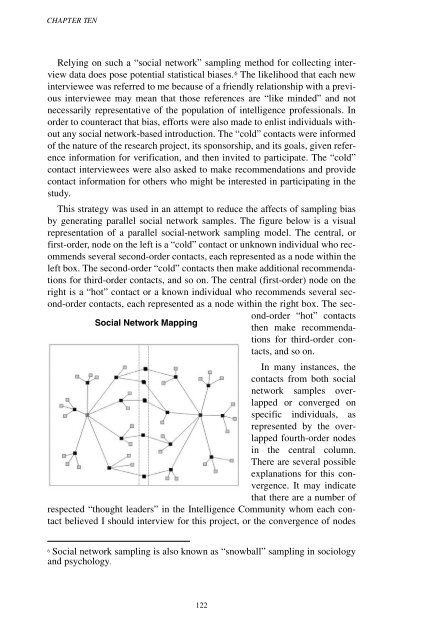Analytic Culture in the U.S. Intelligence Community (PDF) - CIA
Analytic Culture in the U.S. Intelligence Community (PDF) - CIA
Analytic Culture in the U.S. Intelligence Community (PDF) - CIA
You also want an ePaper? Increase the reach of your titles
YUMPU automatically turns print PDFs into web optimized ePapers that Google loves.
CHAPTER TEN<br />
Rely<strong>in</strong>g on such a “social network” sampl<strong>in</strong>g method for collect<strong>in</strong>g <strong>in</strong>terview<br />
data does pose potential statistical biases. 6 The likelihood that each new<br />
<strong>in</strong>terviewee was referred to me because of a friendly relationship with a previous<br />
<strong>in</strong>terviewee may mean that those references are “like m<strong>in</strong>ded” and not<br />
necessarily representative of <strong>the</strong> population of <strong>in</strong>telligence professionals. In<br />
order to counteract that bias, efforts were also made to enlist <strong>in</strong>dividuals without<br />
any social network-based <strong>in</strong>troduction. The “cold” contacts were <strong>in</strong>formed<br />
of <strong>the</strong> nature of <strong>the</strong> research project, its sponsorship, and its goals, given reference<br />
<strong>in</strong>formation for verification, and <strong>the</strong>n <strong>in</strong>vited to participate. The “cold”<br />
contact <strong>in</strong>terviewees were also asked to make recommendations and provide<br />
contact <strong>in</strong>formation for o<strong>the</strong>rs who might be <strong>in</strong>terested <strong>in</strong> participat<strong>in</strong>g <strong>in</strong> <strong>the</strong><br />
study.<br />
This strategy was used <strong>in</strong> an attempt to reduce <strong>the</strong> affects of sampl<strong>in</strong>g bias<br />
by generat<strong>in</strong>g parallel social network samples. The figure below is a visual<br />
representation of a parallel social-network sampl<strong>in</strong>g model. The central, or<br />
first-order, node on <strong>the</strong> left is a “cold” contact or unknown <strong>in</strong>dividual who recommends<br />
several second-order contacts, each represented as a node with<strong>in</strong> <strong>the</strong><br />
left box. The second-order “cold” contacts <strong>the</strong>n make additional recommendations<br />
for third-order contacts, and so on. The central (first-order) node on <strong>the</strong><br />
right is a “hot” contact or a known <strong>in</strong>dividual who recommends several second-order<br />
contacts, each represented as a node with<strong>in</strong> <strong>the</strong> right box. The second-order<br />
“hot” contacts<br />
Social Network Mapp<strong>in</strong>g<br />
<strong>the</strong>n make recommendations<br />
for third-order contacts,<br />
and so on.<br />
In many <strong>in</strong>stances, <strong>the</strong><br />
contacts from both social<br />
network samples overlapped<br />
or converged on<br />
specific <strong>in</strong>dividuals, as<br />
represented by <strong>the</strong> overlapped<br />
fourth-order nodes<br />
<strong>in</strong> <strong>the</strong> central column.<br />
There are several possible<br />
explanations for this convergence.<br />
It may <strong>in</strong>dicate<br />
that <strong>the</strong>re are a number of<br />
respected “thought leaders” <strong>in</strong> <strong>the</strong> <strong>Intelligence</strong> <strong>Community</strong> whom each contact<br />
believed I should <strong>in</strong>terview for this project, or <strong>the</strong> convergence of nodes<br />
6 Social network sampl<strong>in</strong>g is also known as “snowball” sampl<strong>in</strong>g <strong>in</strong> sociology<br />
and psychology.<br />
122
















